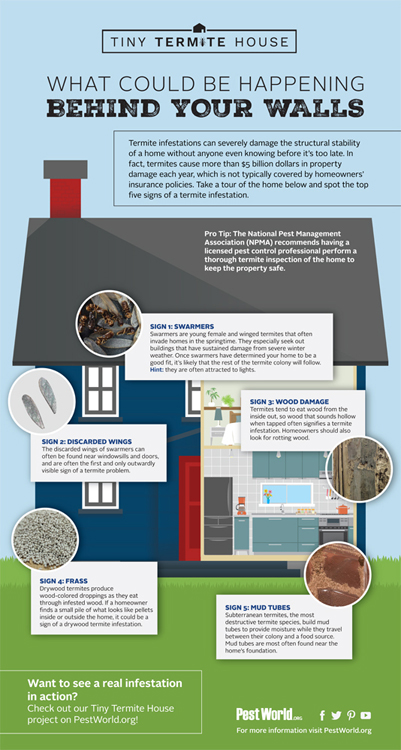The Mystery Behind Your Walls: Could There Be Termites?
![]() Print this Article | Send to Colleague
Print this Article | Send to Colleague
 Termites are one of the most destructive insect species to impact homeowners here in the U.S. In fact, termite infestations cause more than $5 billion in property damage in the U.S. every year — costs that are not typically covered by home insurance policies. NPMA is working to spread awareness about these silent destroyers during Termite Awareness Week, March 11-17, by educating consumers about the structural dangers of termites and providing tips to help prevent infestations.
Termites are one of the most destructive insect species to impact homeowners here in the U.S. In fact, termite infestations cause more than $5 billion in property damage in the U.S. every year — costs that are not typically covered by home insurance policies. NPMA is working to spread awareness about these silent destroyers during Termite Awareness Week, March 11-17, by educating consumers about the structural dangers of termites and providing tips to help prevent infestations.
“Termites are tiny, but the damage they cause if left to their own devices sure is mighty. With spring approaching and termite activity increasing, it’s important to take the proper precautions to protect your greatest investment from these wood-destroying insects,” said Cindy Mannes, vice president of public affairs at NPMA. “Consider adding pest-proofing tasks to your spring-cleaning list, such as remediating sources of excess moisture around the home and having a licensed pest control professional assess your property annually for potential termite issues.”
New this year, NPMA commissioned a first of its-kind research project to visually show homeowners the destructive nature of termites in a controlled environment. The group designed a custom, built-to-scale, miniature dream house, dumped nearly half a million termites into it and has been watching them work together as a colony and wreak havoc behind the home’s walls through a mix of high-definition video and photography. Mud tubes — used by termites to reach a food source and a common sign of termite trouble — quickly formed around the house’s foundation and a full reveal of the damage done by the colony is expected in the coming weeks.
“The goal of this project is to show a never-before-seen view of exactly what goes on between the drywall and floorboards of a home infested by termites. Because termites are so hard to see once inside a structure, they are able to silently chew through critical support beams and other materials uninterrupted, 24-hours a day with the damage often occurring unbeknownst to homeowners,” added Mannes.
Here are NPMA’s top 10 termite prevention tips:
1. Eliminate or reduce moisture in and around the home, which termites need to thrive
2. Repair leaking faucets, water pipes and exterior AC units
3. Repair fascia, soffits and rotted roof shingles
4. Replace weather stripping and loose mortar around basement foundation and windows
5. Divert water away from the house through properly functioning downspouts, gutters and splash blocks
6. Routinely inspect the foundation of a home for signs of mud tubes or wood that sounds hollow when tapped
7. Monitor all exterior areas of wood, including windows, doorframes and skirting boards for any noticeable changes
8. Maintain an 18-inch gap between soil and any wood portions of the home
9. Store firewood at least 20 feet away from the house
10. Consider scheduling a professional inspection annually, and if buying a home, don’t bypass the wood destroying organism inspection
For more information on termites, visit PestWorld.org. For updates on the Tiny Termite House project, visit PestWorld.org/tiny-termite-house or follow @PestWorld social media channels.
About the National Pest Management Association
The NPMA, a non-profit organization with more than 5,500 members, was established in 1933 to support the pest management industry's commitment to the protection of public health, food and property from the diseases and dangers of pests. For more information, visit PestWorld.org or follow @PestWorld on Facebook, Twitter, Pinterest and YouTube.
